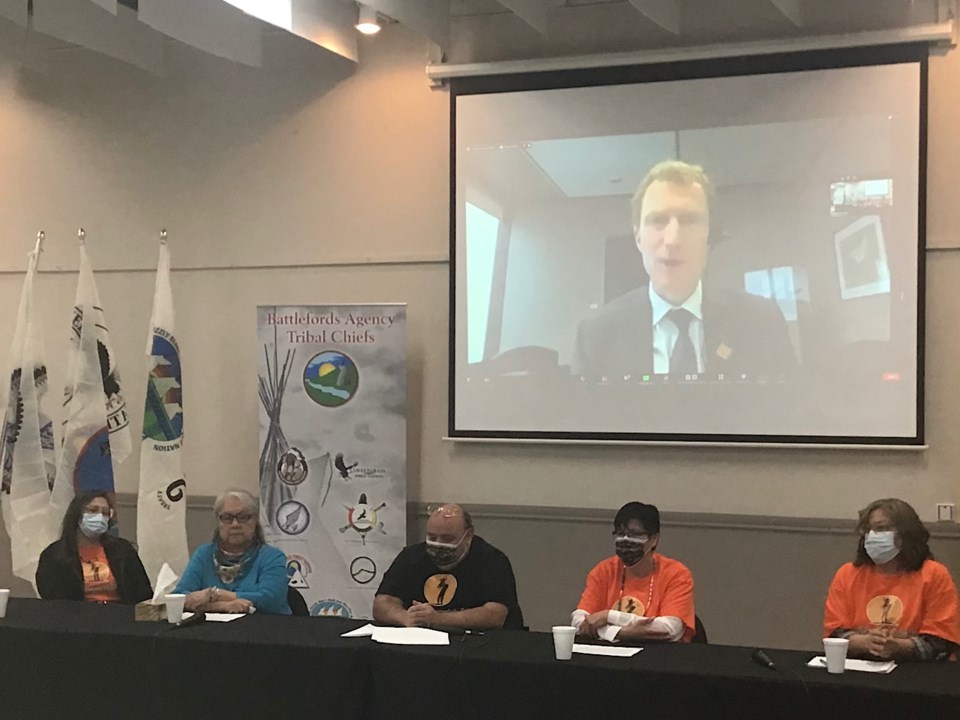NORTH BATTLEFORD – Battlefords Agency Tribal Chiefs is receiving some much-welcome funds from the federal government for its ground-radar search efforts for unmarked graves.
At a news conference Tuesday at Western Development Museum, The Hon. Marc Miller, Minister of Crown-Indigenous Relations, announced support for Battlefords Agency Tribal Chiefs Inc.’s research and commemoration activities around former Residential School sites.
The funding is for $2,783,554 over three years, which according to a government news release goes towards researching, documenting, and honouring the memory of those who attended both the Battleford Industrial School as well as the former St. Henri-Thunderchild Indian Residential School at Delmas.
The federal minister was joined at the announcement by BATC leaders including Chief Cheryl Kahpeaysewat, Tribal Chair of BATC and Chief of Moosomin First Nation, Chief Lori Whitecalf of Sweetgrass First Nation, BATC Indian and residential school searches project manager Karen Whitecalf. and residential school survivor and Senator Jenny Spyglass. Minister Miller appeared by video online from Ottawa.
“It continues to be a dark stain on our history,” said Miller. “The impacts of these two residential schools how many children who never returned home are truths that your Mations have lived with us for generations that many people in Canada have denied.”
Chief Kahpeaysewat welcomed the funding announcement, saying it will “provide answers to the families that went to the two schools.”
“The Battlefords is rich with history and until now, we have forgotten a very important part of history that has been kept secret for too long.”
The funding comes as efforts intensify across the country to search unmarked graves of former students of residential schools, following discoveries of unmarked graves at the Kamloops Residential School and at Cowessess First Nation last year.
Just a week earlier, Keekeekoose First Nation reported it had found 54 potential burial sites that were believed to hold the remains of children who attended residential schools there.
Battlefords Agency Tribal Chiefs has been very active in ground-radar search efforts over the past year in the Battlefords and surrounding are. On July 16, 202, ground radar search efforts began at the site of the former Delmas residential school, which operated from 1901 to 1948. SNC - Lavalin had offered their assistance to BATC and were on the scene to conduct the search.
The plan was to search several sites of interest in Delmas and the surrounding area, as well as the Battleford Industrial School site where there is a grave site for 74 attendees of the Battleford Industrial School. The expectation was that the search would take a year, but it is now expected to take much longer, with the search now expanded to north of Delmas along the North Saskatchewan River.
BATC’s Neil Sasakamoose explained that the ground penetrating radar was used in searching six sites in Delmas last summer, but no graves were detected.
They have been able to identify one marked grave belonging to Henry Achenum, a student at the former Delmas school, which was discovered a mile north of Delmas north of the highway. Sweetgrass Chief Whitecalf is a descendant of Achenum.
“Henry Achenum is just one story of a child that didn’t come home,” said Whitecalf.
Sasakamoose indicated that based on that discovery of Achenum’s grave, it is driving the search towards that area north of Delmas, with more ground radar to be conducted there.
According to Sasakamoose, there were 107 recorded deaths at the Battleford Industrial School, and 44 recorded deaths at the Delmas school.
The thinking, Sasakamoose said, is that both numbers are inaccurate. The intention is to not only find all of the graves, but to match names to numbers and fully tell the story of all of those who had died.
“We’re not here to add numbers to a growing list,” said Sasakamoose. “That’s our goal, we want to give their name to who their families were, and let their families know who they are.”
Sasakamoose admits it is a daunting task, because it is believe many of the graves are on private land and getting cooperation will be a challenge.
The government of Canada announced in 2021 it was allocating approximately $320 million towards support for Indigenous-led and survivor-centric initiatives and investments to help Indigenous communities deal with the impacts of residential schools.
The BATC First Nations include Moosomin First Nation, Red Pheasant Cree Nation, Sweetgrass First Nation, Saulteaux First Nation, Mosquito Grizzly Bear’s Head Lean Man First Nation, Stoney Knoll First Nation, and Ahtahkakoop Cree Nation.



